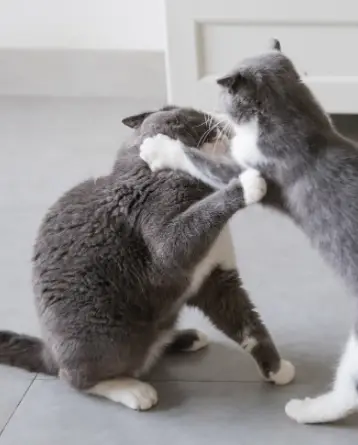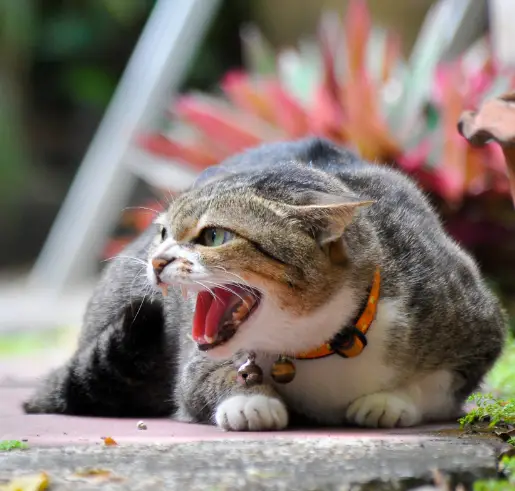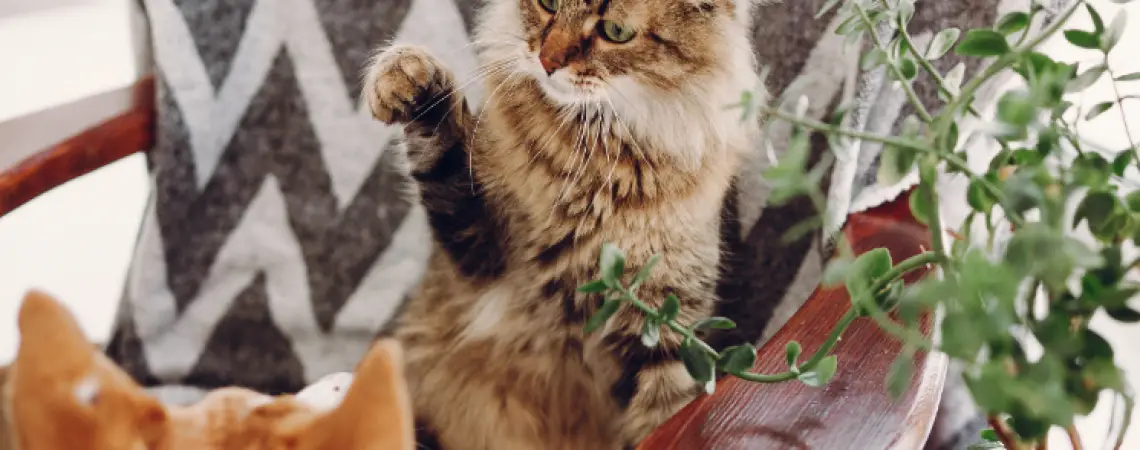For pet parents, few things are as stressful as seeing one of your pets suffer, especially at the paws of one of your other pets. While we’d love for our fur babies to love each other as much as we love them, sometimes they just don’t.
Cats can be very territorial, and they often do not like other cats coming into what they consider their home, eating their food, and taking attention from their humans. When you have two cats, thing can get tricky fast.
In this article, we’re going to talk about the subject of “cat bullying”, and how you can stop one cat from bullying the other cat.
What Behavior Indicates “Cat Bullying”?
Aggressive territorial behavior can take many forms. For most pet parents, they will see one cat attacking the other, but you should also look out for “resource guarding” behavior.
If you free feed your cats then there’s a good chance that one cat could be stopping the other cat from eating. They could even be stopping them from using the litter box, or using toys like the cat tree.
While in most cases, the bully rarely causes serious injury to the weaker cat, this behavior can add stress to your other cat’s life which can impact their health.
Some play fighting between kitty house-mates is to be expected, but if you see that one of your cats is now constantly in hiding, or even avoiding key areas like the food bowl or litter box, it’s time to do something about it.
What causes a cat to become a bully?

Cats can become aggressive to other felines for a lot of reasons. However, the most likely reason is that there is a new cat in the house and your cat is protecting what he or she thinks is their territory.
Though cats can also lash out aggressively for other reasons such as stress. Cats can become stressed by changes to their home, traumatic experiences, and many other things.
However, if your cats are not spayed or neutered, this can also be a source of aggression and you should remedy the problem. For cats, behavioral changes are a part of life, especially for same sex animals, but animals that are fixed have reduced aggression towards each other.
You should also look out for something called “redirected aggression”. This is what happens when your cat is actually aggressive toward something else but then lashes out at either you or your other cat. This can be caused by prey drive, such as watching squirrels out the window which they can’t get to, or even fear from a new noise, or smell.
Why Are My Cats Fighting All of A Sudden?
If your cats have been living together just fine for some time and one has suddenly started showing aggression then there could be another issue at play.
For starters, you may want to schedule a vet visit to make sure that there are no medical issues at play. In some cases, pain or medical ailments could cause aggression in previously docile cats.
However, you should also examine their environment. Did anything else change recently? Did you move? Change something about their living arrangement? Maybe there’s a new person in the house? Anxiety can cause unprovoked aggression in a confused cat as well.
How To Stop Cats From Fighting

“Bullying” when observed in cats is as previously stated, a territorial aggression. This means that in order to get this behavior to stop you may need to make some changes to your household which will establish a territory for both of your cats.
If you live in an apartment or even a house that’s not very large, this can be a challenge. You might need to come up with some creative solutions to create enough space for both cats to be happy. Here are a few ideas.
Get More Litter boxes
If the aggressor has claimed the existing litter box then getting a second one, or even a third, may be necessary. Place this litter box as far away from the other litter box as possible, preferably in a quiet and concealed area, as the victim will likely be skittish and appreciate some privacy to do their business.
Animals heavily rely on scent to mark their territory. This means that your cat may be very unhappy that somebody new is leaving their scent in their litter box.
However, cats also scent mark by rubbing on things, and they could feel similarly about other things in the house which they deem “theirs”. This includes scratching posts and cat trees, bowls, toys, furniture, etc.
Bullying over litter boxes can quickly turn into a stinky situation, because the loser will likely find somewhere else to go if you have only one box. Such as on the rug or in a closet!
TIP – Most experts recommend one litter box per cat, plus one more for safety.
Feed Your Cats Separately
If one of your cats is being bullied then they may be denied food and water by the aggressive cat. Feeding your cats separately is a good way to make sure that one cat is not eating up all the food!
Feeding your cats on a schedule, rather than free feeding them, is also a good way to monitor your cat’s weight and food in take. Put each cat in a separate room and let them out when meal time is over, allowing you to make sure both of them get enough food and water.
Find More Things For Them To Do
It’s entirely possible that your aggressive cat is really just bored. Many pets are not stimulated mentally which gets them into trouble. Try adding some more toys to the mix, especially interactive ones, or spend more time playing with both cats.
Giving your cat access to a window is an easy way to give them a fun activity. A cat will stare out a window watching birds for hours, and give your poor bullied cat some peace.
Pay Attention To Both Cats Equally
For those who have just gotten a second cat, your original cat be be feeling a little jealous. While cats are often portrayed as independent and even a little cold, they still like to get attention from their humans.
While the addition of another cat can be exciting, be sure that you’re still giving equal attention to your other cat. Take some extra time to play with them, or even give them some one-on-one time with you.
Separate The Cats Altogether
If the aggression still has not ceased, you may need to try confining the cats to their own rooms, at least for a little while. The cats should be able to smell and hear each other on the other side of the door but not touch each other.
You can then begin slowly re-introducing them to each other for short visits and hope that the aggression subsides. Don’t expect this to be a fast transition, but it can work if you’re patient with them.
Try Something Calming
While this solution does not work for all cats, calming products like this one help to reduce aggression in cats. If you’ve tried everything else then it’s worth picking this up to see if it will work for your bully cat.
These types of sprays and drops mimic the natural calming pheromones which make cats feel less stressed. They can actually be used to curb a lot of undesirable activities such as aggression, scent marking, etc.
What doesn’t work to stop bullying?
Don’t try to punish your cat or swat at them for bullying. This behavior will only lead to more aggression. Using spray bottles or other tactics often yield much of the same results. Plus, cat’s aren’t dumb. They’ll be resentful for the spritz of water and your cat may just bully the other cat when you’re not looking.
Instead, you’ll likely find that positive re-enforcement works better. By enacting some supervised play sessions involving both cats and handing out treats for good behavior, you might get better results.
You should also avoid comforting the bullied cat and ignoring the bully. This can breed more resentment and jealousy, worsening the problem. The “bully” doesn’t understand that they’ve done something bad, and punishing them in this manner simply won’t get the message across.
How Long Does It Take For Cats To Get Along?
According to PAWS it can take up to 8 months for cats to start getting along.((://www.paws.org/resources/introducing-cat-to-cat/)) This, of course, depends on the individual animals and the situation, but expect this to take a while.
It can be rough going in a multi cat household until that happens, but it’s important to remember that you need to be patient with your cats. Change is stressful on animals, and they need time to adjust. They may even learn to tolerate each other a little sooner, but it could take them quite a while to be “friendly”.


